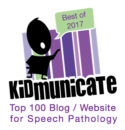
Let’s Get Physical: Keeping PK kiddos attentive during therapy!
So here is my biggest
secret to success with preschoolers: Movement! It is NOT
developmental to expect a PK age child to sit and attend to an activity for 30
or 50 minute sessions. Children are constantly learning, exploring, and
problem solving. They, like us all, need proprioceptive feedback. I
provide that by adding movement to almost ALL of my therapy activities.
When I add movement to any activity, I have learned that my PK students
attend longer to one single activity and will participate in more trials during
the therapy session than if I would expect them to sit the entire time.
The movement does not have to be big or elaborate. Here some simple
examples of how I incorporate movement into some everyday activities we SLPs
LOVE:
- Bingo: We SLPs love our bingo don't we? Articulation
bingo? Grammar bingo? Vocab bingo? I simply place the stimulus cards
(or bingo chips) in another area (all over the floor, along the walls,
hidden the room, on another table, etc.) so that every time we need to use
them, the children get to walk over and get one (or several depending on
the number of trials I am attempting that day).
Memory/Concentration: We love this game for the problem solving,
reasoning, visual memory, task that it truly is while targeting articulation or
other language tasks! How do I add movement into memory? Place the
cards farther apart all over the floor. That's it! So simple and so
effective. Below you see I added tossing
the bean bags to choose a card, but many times I will use little balls (bounce
on the card and it’s yours), or nerf guns/disc slingers (hit a card and it’s
yours) just to mix it up a bit!
- Fishing: We love to have our kids "fish" those stimulus cards! I usually place the "pond" of fish (with stimulus cards attached) on one end of the room, while I am seated at the other end. After the child "catches" his number of fish, he walks over to give me cards and we practice those stimulus cards together.
- Board games: Teaching
a child rules to board games, taking turns, being a good sport, etc. are
invaluable. So it is a MUST that we work on them in therapy.
How in the world do you add movement to board games you ask?
Well the biggest thing I do for activities that are AT a table is I
allow the children to stand! Yes they will move around, they will
squirm, and maybe even find themselves on the floor a few times during
therapy, but the sensory feedback they get from standing and squirming
results in more practice trials...so...I'll take it! (As the
children grow in age and development I will expect longer periods of
sitting in order to prepare them for Kindergarten of course.)
- Bean Bag or Ball Toss games: I love me some bean bag toss games...throwing stimulus
cards all over the floor and having the child throw the bean bag or ball
onto a card (or with a ball it may roll/bounce on several cards), the
child quickly picks up card, brings back to me, we practice...and do it
all over again!
- Hide N Seek: Great
game for teaching pronouns! Also great with use of a ball, nerf gun
(or "dart slinger" if you aren't allowed to use the word gun in
your work environment) or any other object that is soft and can be
"thrown" at stimulus cards. Hide the cards, child finds
the cards, throws/rolls ball or shoots dart at card...practices card and
finds another.
- Crafts: We
love our crafts...great receptive language tasks focusing on following
directions. So place all craft materials somewhere OTHER than the
table you are doing the craft and have the child retrieve the objects you
need (BEFORE giving a complex command so they can focus on the language of
that command after the materials are in front of them).
- Other things I love to do: games that incorporate hopping or jumping, crab
crawling, and yes even dancing. You know I love my music! When
in a school, you have some really great resources with your PE teacher.
Grab a scooter, hula hoops, a dodge ball or a parachute and have
some fun.
Don’t
have access to those things? How about
simple game of Twister? I love to use my
twister mat for this...and add color identification as a side preacademic
concept for kids while using the spinner.
On the spinner I will place words “jump, hop, crawl, dance, frog hop,
etc. over the areas that label left vs. right hand/foot so the students can
follow a gross motor direction while grabbing their stimulus card.
You’ve
done twister? How about a point’s
game? I make points cards (+/- points)
and use our disc slingers after several trials of stimulus cards. Where ever our discs land is how many points
we get after each round. Below you can
see that this game was a family affair during one of my home sessions! It’s always nice to get siblings involved for
support!
Think
of all the ways you can add movement into your therapy! I promise you it
won't take away from your therapy or goals. Allowing a child to perform
within his/her developmental expectations is NEVER out of sync with our goals
as SLPs. And most importantly, remember to have fun!
Happy Talking!
























